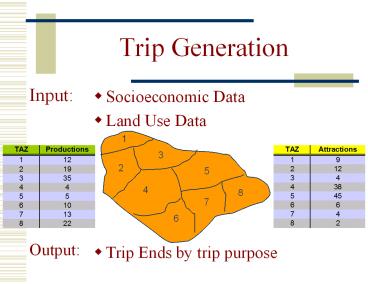Trip%20Generation - PowerPoint PPT Presentation
Title:
Trip%20Generation
Description:
how do we allocate all the trips among all the potential destinations? Zone 1. Trip Matrix ... Typically based solely upon vehicle travel times ... – PowerPoint PPT presentation
Number of Views:511
Avg rating:3.0/5.0
Title: Trip%20Generation
1
Trip Generation
Input
- Socioeconomic Data
- Land Use Data
Output
- Trip Ends by trip purpose
2
Trip Generation Trip Distribution
- The question is how do we allocate all the
trips among all the potential destinations?
Trip MatrixorTrip Table
Zone 1
3
Trip Distribution
4
Trip Distribution
- We link production or origin zones to attraction
or destination zones - A trip matrix is produced
- The cells within the trip matrix are the trip
interchanges between zones
5
Basic Assumptions of Trip Distribution
- Number of trips decrease with COST between zones
- Number of trips increase with zone
attractiveness
6
Methods of Trip Distribution
- Growth Factor Models
- Gravity Model
7
Growth Factor Models
- Growth Factor Models assume that we already have
a basic trip matrix - Usually obtained from a previous study or recent
survey data
8
Growth Factor Models
- The goal is then to estimate the matrix at some
point in the future - For example, what would the trip matrix look like
in 2 years time?
Trip Matrix, t (2008)
Trip Matrix, T (2018)
9
Some of the More Popular Growth Factor Models
- Uniform Growth Factor
- Singly-Constrained Growth Factor
- Average Factor
- Detroit Factor
- Fratar Method
10
Uniform Growth Factor Model
11
Uniform Growth Factor
i I Production Zone j J
Attraction Zone
Tij t tij for each pair i and j Tij Future
Trip Matrix tij Base-year Trip Matrix t
General Growth Rate
12
Uniform Growth Factor
Tij t tij for each pair i and j Tij
Future Trip Matrix tij Base-year Trip
Matrix t General Growth Rate
If we assume t 1.2 (growth rate), then
Trip Matrix, t (2008)
Tij t tij (1.2)(5) 6
Trip Matrix, T (2018)
13
Uniform Growth Factor
- The Uniform Growth Factor is typically used for
over a 1 or 2 year horizon - However, assuming that trips growat a standard
uniform rate is a fundamentally flawed concept
14
The Gravity Model
15
The Inspiration for the Gravity Model
- The big idea behind the gravity model is
Newtons law of gravitation - The force of attraction between 2 bodies is
directly proportional to the product of masses
between the two bodies and inversely proportional
to the square of the distance
M1 M2
F k
r2
16
Some of the Variables
- Tij Qij Trips Volume between i j
- Fij 1/Wcij Friction Factor
- Wij Generalized Cost (including travel
time, cost) - c Calibration Constant
- pij Probability that trip i will be
attracted to zone j - kij Socioeconomic Adjustment Factor
Tij Trips between i j i production
zone j attraction zone Tij f (Pi, Aj,
Cij) Cij Generalized cost of trip from i
to j
17
The Gravity Model
Pi Aj FijKij
Tij Qij
Pipij
SAjFijKij
(Productions)(Attractions)(Friction Factor)
Sum of the (Attractions x Friction Factors) of
the Zones
Fij 1 / Wcij
ln F - c ln W
- The bigger the friction factor, the more trips
that are encouraged
18
To Apply the Gravity Model
- What we need
- Productions, Pi
- Attractions, Aj
- Skim Tables Wij)
- Target-Year Interzonal Impedances
19
Gravity Model Example 8.2
- Given
- Target-year Productions, Pi
- Relative Attractiveness of Zones, Aj
- Skim Table, Wij
- Calibration Factor, c 2.0
- Socioeconomic Adjustment Factor, K 1.0
- Find
- Trip Interchanges, Qij
20
Given
Find Trip Interchanges, Qij
Find Denominator of Gravity Model Equation
AjFijKij
Calculate Friction Factors, Fij
Find Probability that Trip i will be attracted to
Zone j, pij
Target-Year Inter-zonal Impedances, Wij
Given
Calibration Factorc 2.0 Socioeconomic
Adj. FactorK 1.0
Calculate Friction Factors, Fij
1
1
Fij
Fij
Wcij
Wcij
Find Denominator of Gravity Model Equation
AjFijKij
AjFijKijA4F34K34
(5)(0.01)(1.0) 0.05
Find Probability that Trip i will be attracted to
Zone j, pij
0.05
pij
0.3125
S(AjFijKij)
0.16
Find Trip Interchanges, Qij
Qij Pipij (2600)(0.3125) 813
21
- Keep in mind that the socioeconomic factor, K,
can be a matrix of values rather than just one
value
22
The Problem with K-Factors
- Although K-Factors may improve the model in the
base year, they assume that these special
conditions will carry over to future years and
scenarios - This limits model sensitivity and undermines the
models ability to predict future travel behavior - The need for K-factors often is a symptom of
other model problems. - Additionally, the use of K-factors makes it more
difficult to figure out the real problems
23
Limitations of the Gravity Model
- Too much of a reliance on K-Factors in
calibration - External trips and intrazonal trips cause
difficulties - The skim table impedance factors are often too
simplistic to be realistic - Typically based solely upon vehicle travel times
- At most, this might include tolls and parking
costs - Almost always fails to take into account how
things such as good transit and walkable
neighborhoods affect trip distribution - No obvious connection to behavioral
decision-making































